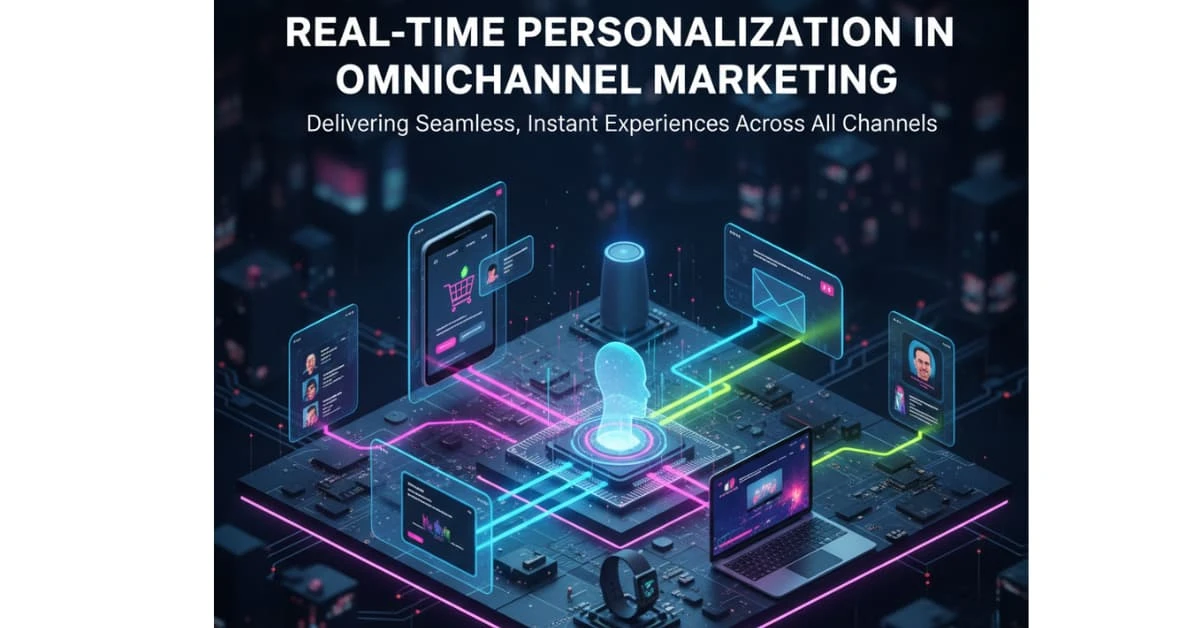What are you looking for?
THE TECH PRODUCT
THE DESIGN STUDIO
THE MEDIA HOUSE
THE MARKETING STUDIO
THE AR LAB

Discover how real-time personalization in omnichannel marketing delivers seamless customer experiences using AI and automation. Learn tools, challenges, and strategies for cross-channel engagement.
In today's hyper-connected world, customers don't interact with a brand through a single, isolated channel; they use a complex mix of websites, apps, social media, email, and physical stores. This is the essence of omnichannel marketing. But simply existing on multiple platforms isn't enough. To truly capture attention and loyalty, brands must deliver experiences that are not just consistent, but also intensely personal and instantly relevant.
Enter Real-Time Personalization—the engine that turns a fragmented omnichannel experience into a seamless, meaningful, and profitable customer journey.
Real-time personalization is the act of instantly tailoring a customer's experience on any channel based on their immediate, in-the-moment behavior, combined with their complete historical profile.
Imagine a customer browsing a product on your mobile app, abandoning their cart, and then opening an email five minutes later.
This level of instant, relevant engagement is the core of cross-channel marketing automation done right.
The biggest hurdle to achieving true real-time omnichannel personalization is data fragmentation. Customer information often lives in separate, siloed systems: CRM, email marketing platforms, website analytics, and POS systems.
To activate personalization at the speed of the customer's click, you need a single, unified view of the customer.
Achieving a connected customer journey requires strategic use of technology and an eye for key moments.
The shift from simple rules-based personalization (e.g., "If they viewed X, show them Y") to truly dynamic, predictive experiences is driven by Artificial Intelligence (AI).
AI and Machine Learning (ML) are critical to scaling real-time personalization because they can:
The result is hyper-personalization—a granular, contextual experience that feels less like marketing and more like a helpful, one-to-one conversation.
Investing in real-time omnichannel personalization isn't just a trend; it's a proven driver of business growth.
In an economy where customer experience is the new competitive battleground, moving beyond consistent messaging to deliver real-time personalization is the key to unlocking the full potential of your omnichannel strategy. Don't just be present across channels—be personal, be relevant, and be instant.
Q1: How is real-time personalization different from automated marketing?
Automated marketing uses pre-set rules and workflows, while real-time personalization adapts content and actions instantly based on live user behavior. It reacts dynamically to data rather than following static schedules.
Q2: Can small businesses implement real-time personalization?
Yes. Many affordable tools such as HubSpot, Zoho CRM, and Klaviyo allow small businesses to create real-time personalized experiences using email automation, behavior tracking, and dynamic website elements.
Q3: How fast should personalization occur to be considered “real-time”?
Real-time personalization typically processes and acts on data within seconds. The faster a brand can analyze and respond, the more effective the personalization becomes.
Q4: What metrics indicate successful real-time personalization?
Key performance indicators include increased engagement rates, reduced bounce rates, improved conversion percentages, and higher customer lifetime value. Tracking user retention and cross-channel
activity also reflects success.
Q5: What is the biggest mistake marketers make with omnichannel personalization?
A common mistake is focusing only on technology while neglecting content strategy. Even the most advanced systems will fail if the messaging lacks relevance, consistency, and emotional appeal.